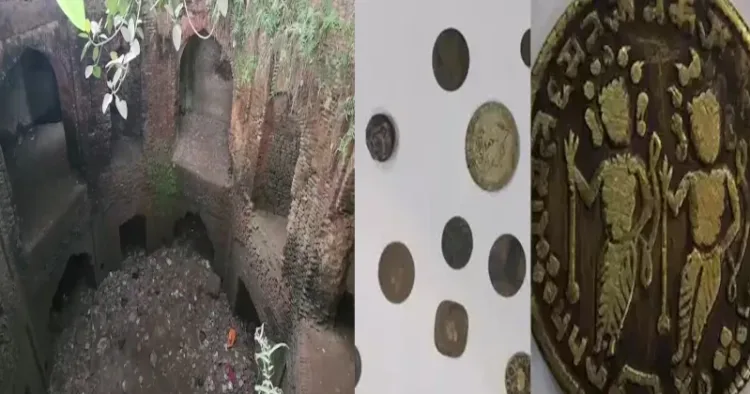An ordinary day of excavation in the Alipur Khurd village of Sambhal turned extraordinary when the sound of clinking metal echoed from the earth, leading to the stunning discovery of ancient gold coins and a historic well. The archaeological find has drawn attention to the region’s rich heritage, as well as the ongoing preservation efforts in the face of sensitive local issues.
The excavation began as part of routine efforts to uncover and protect the region’s ancient sites. SDM Vandana Mishra, accompanied by an ASI (Archaeological Survey of India) team, was conducting a site inspection in the village when the unusual sound was heard during digging. To their astonishment, they unearthed an earthen pot buried beneath the ground, and inside it were several gold coins—some dating back to the British era, while others were even older.
The coins, believed to be 300-400 years old, are expected to provide valuable insights into the region’s past. Experts are now working to authenticate and further study the artifacts, which could shed light on the era in which Guru Amarpati lived and his influence on the region.
Notably, some of the coins featured intricate engravings of Ram, Sita, and Lakshman, highlighting the rich cultural and religious significance of the artefacts.
“The site is believed to be an ancient place of faith in Alipur Khurd village, and the discovery is a significant addition to our historical records. The ASI has protected this site since 1920,” SDM Vandana Mishra explained during the inspection. “In addition to the gold coins, we have found pottery and several coins with remarkable engravings. The figure of Ram, Sita, and Lakshman on one of the coins is especially interesting, as it points to the deep-rooted religious connection of the area.”
Local historians and archaeologists are now working to further study and authenticate these coins, which may offer valuable insights into the region’s past and its connections to various historical periods. The ASI team has also expressed interest in uncovering more artefacts from the site, as it may reveal details about the local culture, trade practices, and religious beliefs throughout history.
While the discovery of the gold coins has captivated the community, it was not the only significant find in Sambhal this week. On January 22, the administration began excavating an ancient well located near the Shahi Jama Masjid, a site fraught with historical and religious tension. The well, believed to be one of 19 ancient wells in the region, was found under illegal encroachments and had been covered up over the years. It is situated about 50 meters from the disputed Shahi Jama Masjid-Harihar temple, a site that has been the focus of political and religious controversy since a court-ordered survey of the mosque in November.
The excavation of the well has sparked renewed interest in the region’s heritage, as locals claim the well holds significant religious and historical value. According to long-time residents, the well was once a revered place of worship, frequented by people during key life events such as childbirth, weddings, and other auspicious occasions. The covering and alteration of the well’s original structure had long been a source of frustration for the community, which considers it a sacred site.
“This well is located near the Harihar temple, and it was once a place where people gathered for prayers and rituals during important moments in their lives,” said Sanjay Kumar, a local resident. “Over time, the well was covered, and its original form was lost. We hope that with this excavation, it will be restored to its former glory, allowing future generations to witness and appreciate its historical and cultural significance.”
The excavation of the well was prompted by complaints from locals about the illegal encroachments that had altered the well’s structure. Assistant Superintendent of Police (ASP) Shirish Chandra confirmed that the excavation was part of a broader effort to restore and protect the region’s ancient heritage. “Preliminary investigations suggest that the well had been encroached upon and covered. We are working to uncover and restore it, and once the excavation is complete, we will take appropriate legal action,” said ASP Chandra.
The well’s historical and religious importance is yet to be fully verified. However, according to local accounts, the well has been a part of the region for centuries. The ongoing excavation is expected to shed more light on its origins and help verify its significance in the broader historical context of Sambhal and its surrounding areas.
This excavation comes amid ongoing tensions in Sambhal, stemming from the controversial court-ordered survey of the Shahi Jama Masjid in November. The survey, which was carried out after claims surfaced that a Harihar temple once stood at the mosque’s location, led to widespread protests and violence. On November 24, clashes between security forces and protesters resulted in stone pelting, arson, and the tragic loss of four lives, with many others suffering injuries. The unrest has heightened the sensitivity surrounding the region’s religious sites and heritage.
The administration’s efforts to restore and preserve the region’s historical landmarks have thus far remained a focal point of public attention. Despite the tense atmosphere, local officials are determined to ensure that these sites are protected for future generations. The discoveries in Alipur Khurd village and the restoration of the ancient well are just two examples of a broader initiative to safeguard Sambhal’s cultural and historical heritage, which has faced both legal and physical challenges over the years.




















Comments